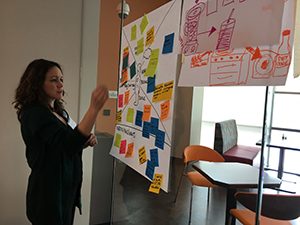Emergency departments within Chicago’s hospitals face a major challenge. The city’s child minority populations are more likely to suffer from asthma than their white counterparts. For a number of reasons, their families overwhelmingly send their kids to the emergency room (ER) for asthma attacks. The IIT Institute of Design in Chicago is teaming up with 13 of the city’s institutions, including six major hospitals to solve this issue.
 Piggy-backing off research suggesting families are often sent home from the ER without understanding how to best manage their children’s chronic health condition, the design team sought to find inadequacies in the discharge process. Their work included interviewing caregivers of children with asthma, the entire ER care team and primary care physicians to identify problems and define solutions to satisfy all stakeholder needs.
Piggy-backing off research suggesting families are often sent home from the ER without understanding how to best manage their children’s chronic health condition, the design team sought to find inadequacies in the discharge process. Their work included interviewing caregivers of children with asthma, the entire ER care team and primary care physicians to identify problems and define solutions to satisfy all stakeholder needs.
The result was the creation of an educational tool that helps families understand the medication process, enables child engagement, promotes conversation between ER doctors and caregivers, offers online resources and can easily be shared with primary care physicians and others who need to know how to care for the child.
Stakeholders were part of the iterative process as the tool was developed to ensure it accommodates all of those who would use it. The IIT design team is expected to wrap up a study on whether the educational plan improves patient outcomes this year.
A number industries and organizations all over the world are integrating this human-centered approach to design to meet the needs of the people they serve. Hospitals are just beginning to embrace this way of solving health care issues. OSF HealthCare is among the few adopting this discipline of design. By bringing humans to the center, design is applied to not only delivering products for more convenience and joy of use but also encouraging the adoption of new behaviors and lifestyles of people.
Human-Centered Design in Health Care
Our everyday lives depend on health. While medical institutions today primarily focus on providing care in medical settings, we can safely state that the front door of health care is often not the front door of the hospital. It is in people’s lives that are impacted by family members, friends, and employers; experiences; social circumstances; and their ability to navigate complex health care information.
Human-centered design seeks to capture an overall look of the health care journey for patients and their families. Design can help hospital systems like OSF better understand those they serve and take actions to empower patients and their caregivers to overcome obstacles in their lives and achieve healthier days ahead.
Designers also pay equivalent attention to the other side of the system, those who serve patients on a daily basis (the Mission Partners). Since service providers experience the various elements of health care, the human-centered approach is applied to improve the culture of both clinical and nonclinical members of the system.
Experience as a Competitive Force
Health care systems are no longer alone in keeping people healthy. Today we see retailers and franchised care centers entering the industry. To stay competitive, traditional health care providers (such as OSF) need to think of better ways to set themselves apart or come up with innovative practices to lead this field.
 With the rise of a consumer mindset in the younger generations, individuals nowadays are paying for not only an outcome but also the experience of care. Factors such as a sense of empathy and user-friendliness have become big differentiators in a patient’s satisfaction and loyalty.
With the rise of a consumer mindset in the younger generations, individuals nowadays are paying for not only an outcome but also the experience of care. Factors such as a sense of empathy and user-friendliness have become big differentiators in a patient’s satisfaction and loyalty.
Employing human-centered design is helping in this effort by identifying unique patient desires and what types of experiences they are seeking from the beginning to the end of the process.
Designers employ human-centric approaches as well as deep, personal and coherent understandings on all user groups and stakeholders. The strategies generated from design help organizations imagine what the future could be, as well as depict how to get there and why it is important to act now.
A Culture of Innovation
The outcome of design has grown beyond the artifact to interventions and cultural change. It has an impact on how we communicate within and outside an organization. In-house designers influence other roles in the health care system, enabling our Mission Partners with questions to ask while innovating for better patient experiences.
OSF has engaged our human-centered design group to contribute to a culture of innovation, encouraging both clinical and nonclinical employees to think and work differently. I encourage you to visit the OSF Innovation website and see for yourself the unique approaches we are taking to our population’s care today.
Last Updated: July 18, 2017